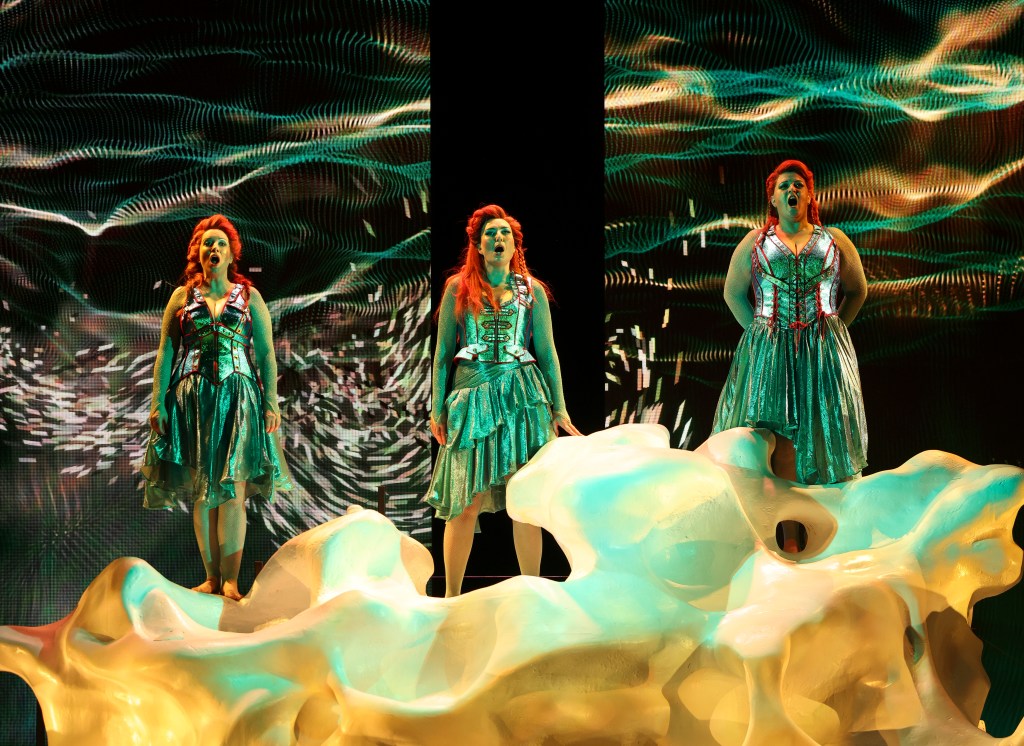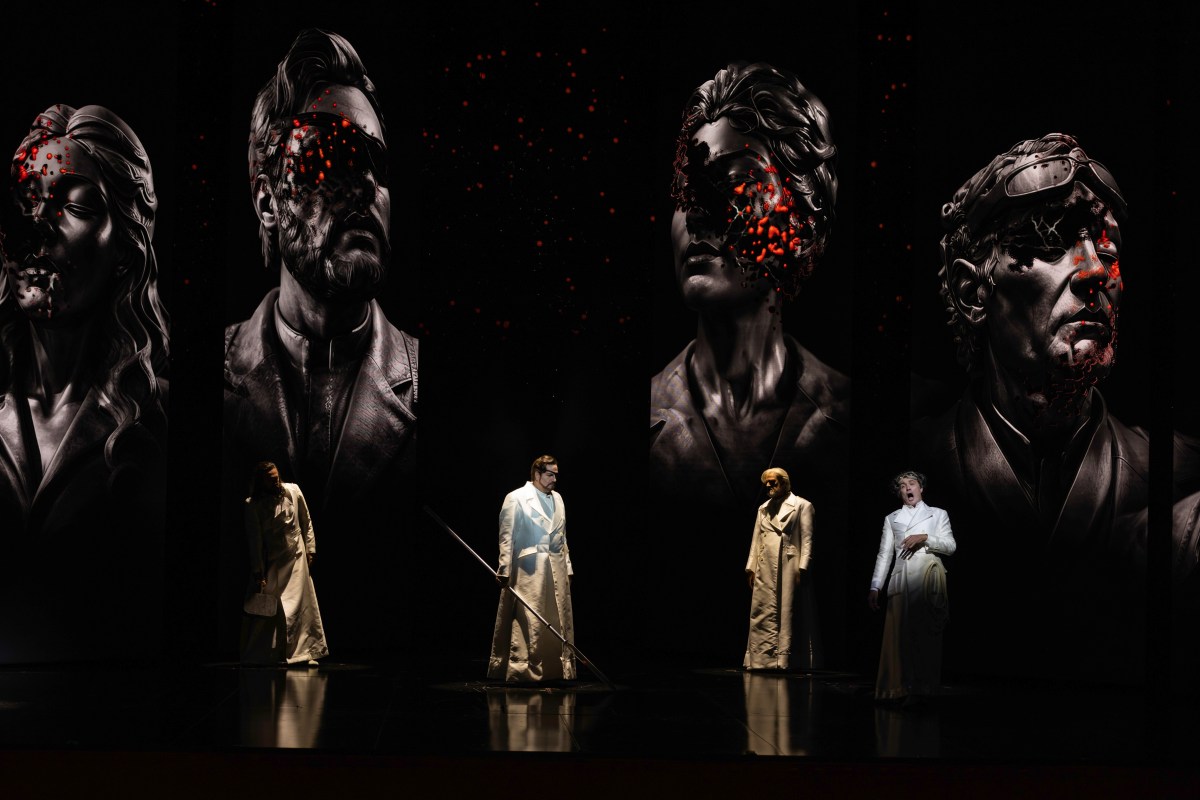Keenly anticipated, Richard Wagner’s mammoth 16-hour Der Ring des Nibelungen (The Ring) is the first fully staged Ring Cycle to be presented in Queensland. In the tradition of Greek, Norse and Germanic myths it is regarded as the pinnacle of operatic repertoire – an epic saga of gods, heroes, dwarves and dragons. The central theme is a cursed and all-powerful magic ring that inevitably leads to the downfall of those (gods included) that try to possess it. Its story has inspired many, including J R R Tolkien’s Lord of the Rings and George R R Martin’s The Game of Thrones.
Focusing on basic mythological tropes that cover the depths to the heights of human emotions, The Ring enthrals because the lust for power, alongside the craving for love and redemption, continues to resonate. Its demanding and universally praised musical score requires huge orchestral resources and dramatically powerful operatic voices. To accommodate its musical and dramatic complexity, Wagner created a new musical form through his clearly identified character “leitmotifs” that are intrinsically and cleverly woven into the score.
Often described as a gesamtkunstwerk, a total work of art, The Ring required Wagner to match his music with his visual imagery. Detailed stage directions were written to mirror the heightened emotions of the music. Both reality and symbolism abound, giving directors and stage designers a not inconsiderable leeway in interpretation.
Visionary Chinese American director and production designer, Chen Shi-Zheng, was engaged by Opera Australia to create this new production of The Ring as its first fully-staged digital production. Digital content designer, Leigh Sachwitz, together with flora&faunavisions, have utilised a series of suspended LED screens with AI auto-generated graphics and video content creation, audiovisual projections and 3D printed set pieces, to realise the staging. Combining Wagner’s magnum opus with contemporary technologies is attractive to audiences already familiar with popular works such as Avatar, Dune, Disney-styled animation and science-fiction films.
The result is, in many ways, a quite astonishing reimagining of the theatrical stage, where Shi-Zheng has relocated the setting from the German Rhineland, integrating elements of Chinese mythology and the Australian tropics to add an Asian perspective.
And so, to Das Rheingold, the first and shortest of the four operas – a one-act preliminary work where the Nibelungen dwarf, Alberich, steals the Rheingold and sets the operatic wheels in motion. The characters in this opera are all supernatural, mythological beings, but demonstrate eternal human attributes in all their glory and failings.
The Prelude to the opera is musically one of Wagner’s finest and here it was used visually to transpose the scene from the depths of the river, where the Rhinemaidens were guarding the Rhine gold, to the warm waters of the Pacific.

The front curtain emblazoned with the words Das Rheingold ran with water imagery during the opening bars. Bubbling water effects rose from the bottom upwards as the curtain lifted to reveal the charming Rhinemaidens, Woglinde (Lorina Gore), Wellgunde (Jane Ede) and Flosshilde (Dominica Matthews). With their shimmering mermaid blue and green outfits topped with flaming red hair, they moved lazily through a large coral reef.
The green-blue watery screens behind depicted projected images of rippling water and gentle waves, while the singers’ choreographed doubles, dressed identically, did aerial somersaults, creating bubbles and waves as they “swam” high up in the water above. This magical imagery, combined with Wagner’s lush musical lyricism, greatly enhanced the live theatre experience. Matthew Marshall lit the whole scene brilliantly, especially the glittering gold with its ghostly aura.
Next came the beautiful clean lines of a three-sided white box in which the ruler of the gods, Wotan, and his wife Fricka, reclined as dawn broke over the newly constructed Valhalla. Wearing uniforms of beautifully fitted full-length white coats from costume designer, Anita Yavich, the gods displayed an arrogant authority, however misplaced. It was easy to see cracks developing, including in the disconcerting images of the gods on huge screens that began to crumble digitally as Freia’s apples of eternal use threatened to be lost.
The white walls and screens also gave way to various shades of colour, mostly red-tinged, with the arrival of Loge (an energetic Hubert Francis), the giants Fasolt (a resolute David Parkin) and Fafner (a dark-throated and evil Andrea Silvestrelli) and their unfortunate prey, the goddess Freia (charmingly sung by Mariana Hong).
The underground Nibelheim, home to the dwarves, with its atmospheric dark, gleaming gloom and accompanying brooding music, was impressively recreated digitally. Here Alberich’s downtrodden brother, Mime, forged the ring and Tarnhelm, a magical cap of invisibility. Mime was sung by a strong-voiced Andreas Conrad, giving a performance of some depth.
As the story unfolded, the music replaced realistic scenic images with more abstract ones providing backdrops of visual imagery in various hues. These were used by the director to represent the emotions and the inner thoughts of key characters, often linking with more than one musical leitmotif to illustrate a state of mind, as Wagner intended.
Some effects worked less well, including weak imagery to depict Alberich when he changed into a serpent and a toad. This offered no sense of the power of the Tarnhelm or of Wotan and Loge’s ability to restrain Alberich, a key moment in the plot. Additionally, the squabbling over the gold and its ownership leads to the shocking death of Fasolt at his brother Fafner’s hands. This well illustrates the powerful curse of the ring, but was passed over too quickly, with little reaction from the gods.
The final digital representation when the gods cross into Valhalla appeared confusing. On one level it seemed joyous, the screens depicting psychedelic imagery alongside stylised kabuki dancing by Dancenorth and Opera Australia dancers. Yet the back screen remained grey and misty, its narrow bridge appearing to show Valhalla to be a miserable, forlorn place. Perhaps Loge summed it up in the final musical bars, seeing the gods hastening to their end. Interestingly, Shi-Zheng chose not to visualise the mighty fortress built by the giants, which was a great pity.
Overwhelmingly, Das Rheingold offered a well-directed narrative that was dramatically realised and well-sung by a splendid cast. The gods, Froh (Dean Bassett) and Donner (Alexander Sefton), tenor and bass-baritone respectively, were vocally well-matched. Liane Keegan made an impressive entrance as the earthy goddess, Erda, with her eerie rise and descent through a trap door.
Cutting a fine figure as the ruler of the gods, Daniel Sumegi’s solid bass-baritone was authoritative, equally displaying his character’s many weaknesses. As his wife, Fricka, Deborah Humble was long-suffering but feisty, and offered her fine mezzo. Warwick Fyfe gave a magnificent performance as the evil, unedifying Alberich, his powerful unwavering bass-baritone introducing humour into this role. And Hubert Francis’ expertly crafted Loge, with pilot goggles and spiky hair, made the quick-witted and all-seeing god of fire a fine foil for the dwarf.
Musically, the Queensland Symphony Orchestra was in safe hands under the strong baton of French conductor, Philippe Auguin, a veteran of Wagner’s work. This was a well-crafted, finely nuanced Das Rheingold, intelligently and carefully conducted. His masterful interpretation was centred on delivering the characters’ leitmotifs in their many expressive forms.
Orchestral instruments helped delineate the nuances of the score, much in the style of the Greek chorus that Wagner wanted. Auguin was exemplary in his cueing of the singers, whose workload was punishing. In particular the horns, trumpets and Wagner’s tuba, alongside the glorious rendition of the anvils in the forge of Nibelheim, were well-balanced.
Read: Event review: ganbu marra runway, THE LUME
Such a beginning dramatically and musically boded well for the remaining three operas of the tetralogy.
Das Rheingold (Preliminary evening, music drama in one act)
by Richard Wagner, with libretto by the composer
QPAC
Conductor: Philippe Auguin
Director: Chen Shi-Zheng
Associate Set Designer: Maruti Evans
Digital Content Designer: Leigh Sachwitz,
Interactive Content Design and Programming: flora&faunavisions
Costume Designer: Anita Yavich
Lighting Designer: Matthew Marshall
Choreographer: Akasa Ruthy Inchaustegui
Cast: Lorina Gore, Jane Ede, Dominica Matthews, Warwick Fyfe, Daniel Sumegi, Deborah Humble, Mariana Hong, David Parkin, Andrea Silvestrelli, Dean Bassett, Alexander Sefton, Hubert Francis, Andreas Conrad, Liane Keegan
Opera Australia Dancers, Dancenorth Australia, Queensland Symphony Orchestra
Das Rheingold was performed 1, 8 and 15 December 2023.





